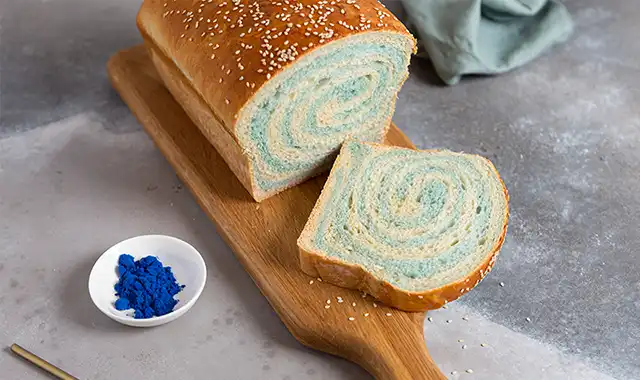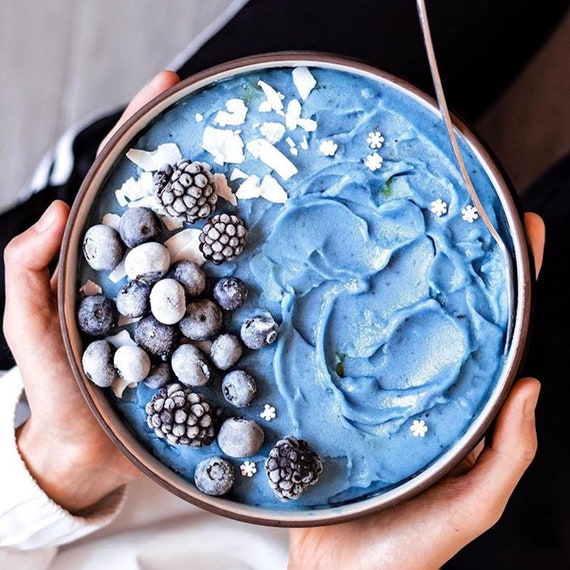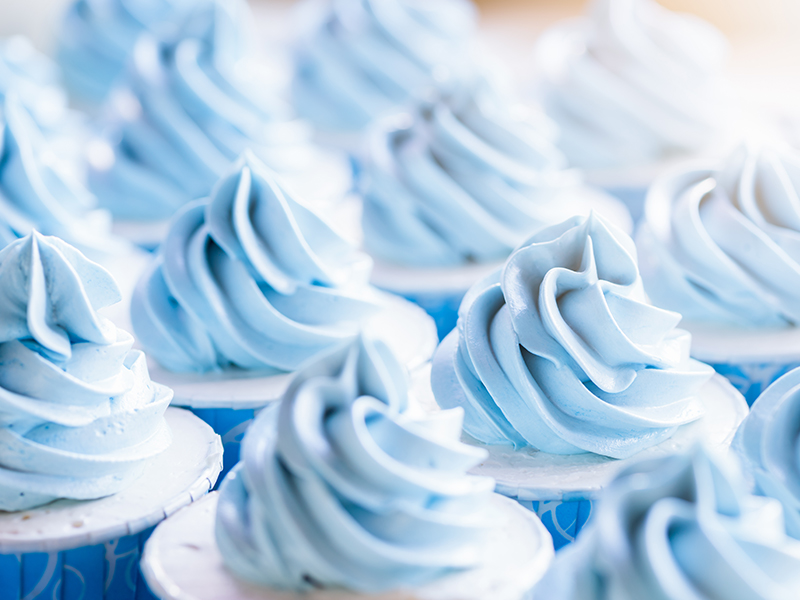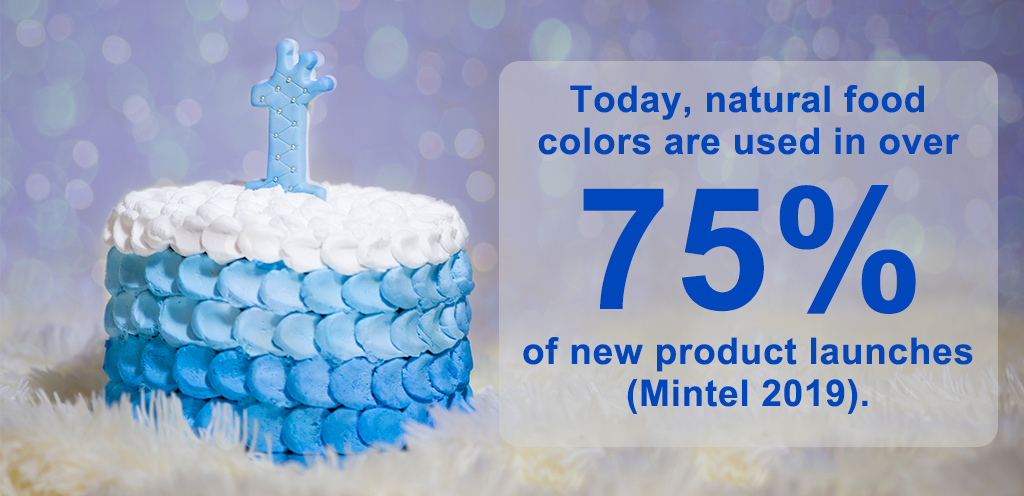Application of food additive phycocyanin in baking
Blue is one of the most popular colors in the world. One third of the world's brand colors are blue, such as Facebook, Twitter, LinkedIn, Skype, Dell, PayPal, blue is also the sea and the sky. No one can resist this wonderful color, and it is perfect for attracting attention on social media.
But in food, apart from blueberries, the color blue is not closely associated with food. However, more and more food and beverage companies are beginning to look forward to the emergence of blue foods. Phycocyanin makes this possible. In fact, 30% of desserts launched in the past five years claim to use natural ingredients (Mintel 2019).

Phycocyanin: A Natural Choice for Baking
Phycocyanin is a natural blue pigment from spirulina, changing the game in the baking industry. Since consumers are seeking healthier, cleaner-label products, phycocyanin gives vibrant colors without sacrificing natural integrity.
- Clean-Label and Plant-Based: Its natural origin makes it suitable for vegan, organic, and sustainable baked goods.
- Vivid Visual Appeal: The unique sky-blue hue makes the product visually appealing, creating eye-catching treats for social media.
- Enhances Perceived Quality: Bright colors enhance flavor perception and enhances premium appeal.
- Health Benefits: High in antioxidants and proteins, it supports the functional food trend.
- Safe and Approved: Widely approved in North America and Europe, phycocyanin guarantees compliance and trust.
Phycocyanin combines natural beauty, nutrition, and versatility, making it an essential ingredient for innovative and visually stunning baked goods.

Phycocyanin Baking Applications Transforming with Natural Color
With the consumers' increased quest for appealing baked goods and health-conscious products, manufacturers are opting for innovative natural ingredients to cater to these needs. Phycocyanin is a natural blue pigment extracted from spirulina and has proven to be the best additive for the baking industry. This is because of its stunning ability to add an attractive blue hue while meeting the clean-label requirements, which bakers and food technologists cannot ignore.
1. Cakes and Cupcakes
Phycocyanin is perfect for the brightening of cake batters and frostings. That way, the bakers would be able to make spectacular products for baby showers, weddings, and birthday parties where one needs special colors.

2. Cookies and Biscuits
The colorant can be mixed into cookie dough for making a colorful treat, or it may be used for the decoration purposes by adding the colorant in the glaze or in a decorative icing for an amazing appearance.

3. Pastries and Pies
Phycocyanin can be used as a color for glazes, fillings, or decorative accents for pastries and pies. The natural blue color adds an elegant and premium feel, making the pastries and pies more attractive to consumers

4. Donuts and Muffins
Bakers may add a splash of color to icings or glazes on donuts using phycocyanin. In turn, muffin batters could be enhanced with phycocyanin or use colorful toppings.

5. Specialty Desserts
Layered desserts, such as mille-feuille or entremets, can be enhanced with phycocyanin by creating gradients or mixing it with other natural pigments for multi-colored effects.

6. Decorative Applications
Phycocyanin is ideal for decorative purposes, such as edible flowers, patterns, or lettering, which can give baked goods a unique look.

Visual Appeal in Baking
In the digital age, visual appeal is a powerful driver of consumer behavior. More than 43% of millennials share food photos on social media weekly, and hashtags like #cakesofinstagram highlight the growing demand for unique and colorful creations. Phycocyanin’s vibrant sky-blue hue transforms cakes, cookies, and pastries into Instagram-worthy masterpieces, boosting brand visibility and customer engagement.
Additionally, studies have shown that visually appealing products can enhance perceived flavor and quality, increasing the likelihood of repeat purchases. Phycocyanin enables bakers to create eye-catching goods that stand out on the shelves and social media feeds.

Natural Food Coloring That Pleases Consumers
The combination of vibrant color, natural source, and purported health benefits offers phycocyanin as a ground for differentiation in food coloring for baking. Consumers today are seeking products that do more than look good – in fact, they should align with the desire of clean-label, plant-based, and functional ingredients that consumers want to use.
Phycocyanin not only produces awe-inspiring blue shades in baked goods but also provides a natural, spirulina-derived origin that appeals to growing demand for transparency and sustainability. Moreover, with antioxidant and protein content, it provides a functional advantage and meets health-conscious buyers' desires.
Phycocyanin is safe, approved, and versatile. It is the ultimate natural food coloring delighting consumers and bakers alike.

Conclusion
Phycocyanin is revolutionizing the baking industry by offering a natural, vibrant blue hue that meets consumer demands for clean-label, visually appealing, and nutritious products. From cakes and cookies to pastries and specialty desserts, the applications of phycocyanin are vast and versatile.
As bakers and food manufacturers continue to innovate, phycocyanin stands out as a key ingredient for creating products that not only look stunning but also align with modern values of health, sustainability, and creativity. Reach out to us at info@yanggebiotech.com for more information on our high-quality phycocyanin products and how they can support your journey to optimal health and wellness.
References
Dagnino-Leone, J.; Figueroa, C.P.; Castañeda, M.L.; Youlton, A.D.; Vallejos-Almirall, A.; Agurto-Muñoz, A.; Pavón Pérez, J.; Agurto-Muñoz, C. Phycobiliproteins: Structural aspects, functional characteristics, and biotechnological perspectives. Comput. Struct. Biotechnol. J. 2022, 20, 1506–1527. [Google Scholar] [CrossRef]
Stadnichuk, I.N.; Tropin, I.V. Phycobiliproteins: Structure, functions and biotechnological applications. Appl. Biochem. Microbiol. 2017, 53, 1–10. [Google Scholar] [CrossRef]
Brejc, K.; Ficner, R.; Huber, R.; Steinbacher, S. Isolation, crystallization, crystal structure analysis and refinement of allophycocyanin from the cyanobacterium Spirulina platensis at 2.3 Å resolution. J. Mol. Biol. 1995, 249, 424–440. [Google Scholar] [CrossRef] [PubMed]
Glazer, A.N. Light guides. J. Biol. Chem. 1989, 264, 1–4. [Google Scholar] [CrossRef] [PubMed]
Scheer, H.; Zhao, K.-H. Biliprotein maturation: The chromophore attachment. Mol. Microbiol. 2008, 68, 263–276. [Google Scholar] [CrossRef] [PubMed]
Adir, N.; Dobrovetsky, Y.; Lerner, N. Structure of c-phycocyanin from the thermophilic cyanobacterium Synechococcus vulcanus at 2.5 Å: Structural implications for thermal stability in phycobilisome assembly 1 1Edited by R. Huber. J. Mol. Biol. 2001, 313, 71–81. [Google Scholar] [CrossRef]
Kannaujiya, V.K.; Kumar, D.; Pathak, J.; Sinha, R.P. Phycobiliproteins and Their Commercial Significance. In Cyanobacteria; Elsevier: Amsterdam, The Netherlands, 2019; pp. 207–216. [Google Scholar]
Ma, J.; Hu, J.; Sha, X.; Meng, D.; Yang, R. Phycobiliproteins, the pigment-protein complex form of natural food colorants and bioactive ingredients. Crit. Rev. Food Sci. Nutr. 2024, 64, 2999–3017. [Google Scholar] [CrossRef] [PubMed]
Kovaleski, G.; Kholany, M.; Dias, L.M.S.; Correia, S.F.H.; Ferreira, R.A.S.; Coutinho, J.A.P.; Ventura, S.P.M. Extraction and purification of phycobiliproteins from algae and their applications. Front. Chem. 2022, 10, 1065355. [Google Scholar] [CrossRef]
Li, W.; Su, H.-N.; Pu, Y.; Chen, J.; Liu, L.-N.; Liu, Q.; Qin, S. Phycobiliproteins: Molecular structure, production, applications, and prospects. Biotechnol. Adv. 2019, 37, 340–353. [Google Scholar] [CrossRef]

